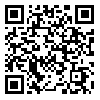Wed, Jul 17, 2024
[Archive]
Volume 19, Issue 3 (September 2022)
IJMSE 2022, 19(3): 88-99 |
Back to browse issues page
Download citation:
BibTeX | RIS | EndNote | Medlars | ProCite | Reference Manager | RefWorks
Send citation to:



BibTeX | RIS | EndNote | Medlars | ProCite | Reference Manager | RefWorks
Send citation to:
Soroori P, Baghshahi S, Kazemi A, Riahi Noori N, Payrazm S, Aliabadizadeh A. Room Temperature Cured Hydrophobic Nano-silica Coatings for Outdoor Insulators Installed on Power Lines without Shutting Down the Current. IJMSE 2022; 19 (3) :88-99
URL: http://ijmse.iust.ac.ir/article-1-2598-en.html
URL: http://ijmse.iust.ac.ir/article-1-2598-en.html
Pooyan Soroori 
 , Saeid Baghshahi
, Saeid Baghshahi 
 , Arghavan Kazemi
, Arghavan Kazemi 
 , Nastaran Riahi Noori
, Nastaran Riahi Noori 
 , Saba Payrazm
, Saba Payrazm 
 , Amirtaymour Aliabadizadeh
, Amirtaymour Aliabadizadeh 


 , Saeid Baghshahi
, Saeid Baghshahi 
 , Arghavan Kazemi
, Arghavan Kazemi 
 , Nastaran Riahi Noori
, Nastaran Riahi Noori 
 , Saba Payrazm
, Saba Payrazm 
 , Amirtaymour Aliabadizadeh
, Amirtaymour Aliabadizadeh 

Abstract: (9683 Views)
The goal of the present study is to prepare a room temperature cured hydrophobic and self-cleaning nano-coating for power line insulators. As a result, the installed insulators operating in power lines can be coated without being removed from the circuit and without the need to cut off power. For this purpose, hydrophobic silica nanoparticles were synthesized by sol-gel method using TEOS and HMDS. The synthesized hydrophobic silica nanoparticles were characterized by XRD, FTIR, SEM, and TEM analyses to investigate phase formation, particle size, and morphology. Then the surface of the insulator was cleaned and sprayed by Ultimeg binder solution, an air-dried insulating coating, as the base coating. Then the hydrophobic nano-silica powder was sprayed on the binder coated surface and left to be air-cured at room temperature. After drying the coating, the contact angle was measured to be 149o. Pull-off test was used to check the adhesion strength of the hydrophobic coating to the base insulator. To evaluate the effect of environmental factors, UV resistance and fog-salt corrosion tests were conducted. The results showed that 150 hours of UV radiation, equivalent to 9 months of placing the samples in normal conditions, did not have any significant effect on reducing the hydrophobicity of the applied coatings.
Type of Study: Research Paper |
Subject:
Ceramics
Send email to the article author
| Rights and permissions | |
 |
This work is licensed under a Creative Commons Attribution-NonCommercial 4.0 International License. |





